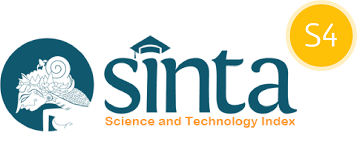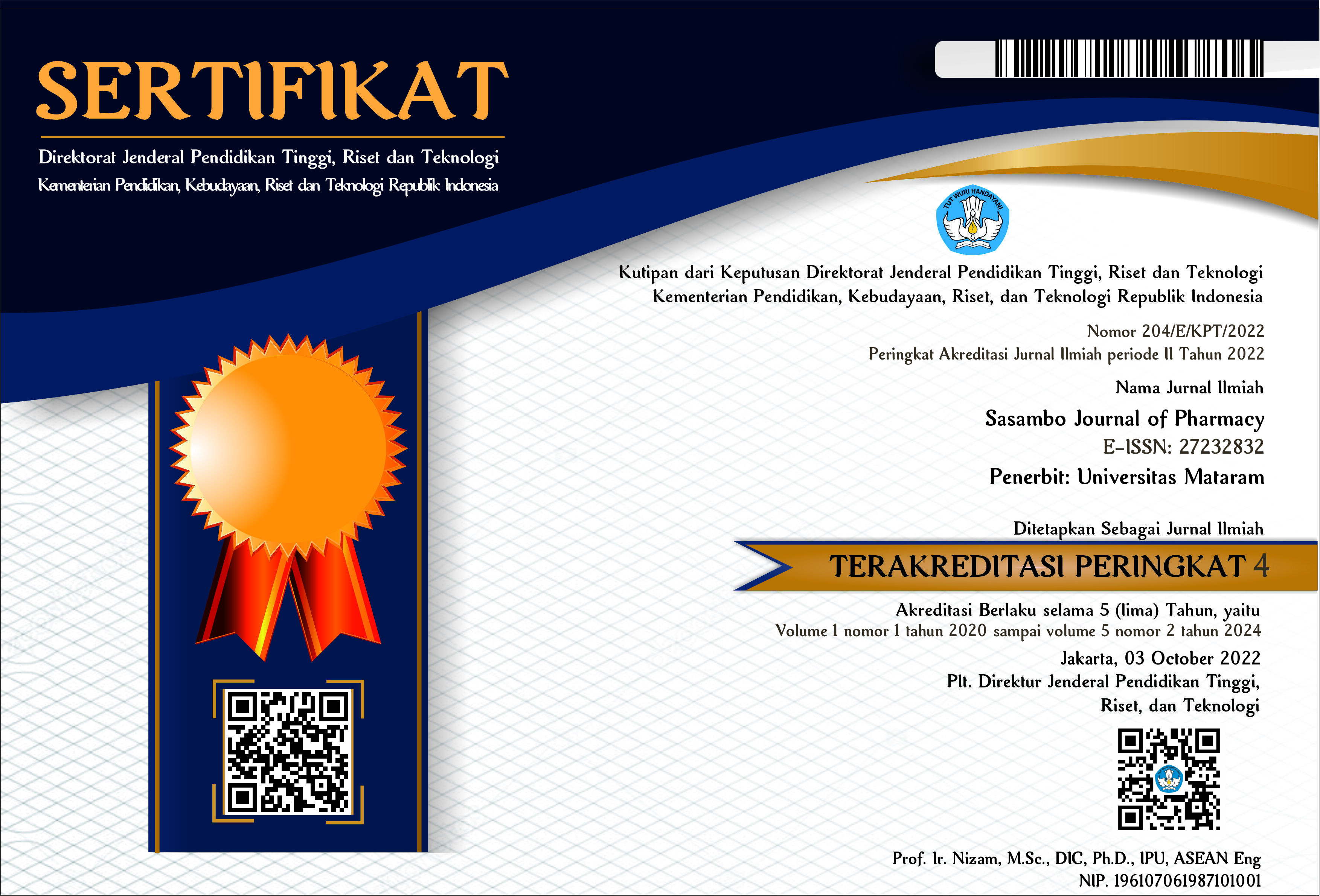Aktivitas antioksidan ekstrak etanol daun pecut kuda (Stachytarpheta jamaicensis (L.) Vahl) menggunakan metode ekstraksi berbasis gelombang ultrasonic
DOI:
10.29303/sjp.v2i2.85Downloads
Abstract
 Free radical is an atom or molecule that has unpaired electrons, is reactive and unstable which can cause damage to cells and tissues. Secondary metabolite compounds in plants such as phenolics, flavonoids, tannins, and saponins can inhibit free radicals. One of the plants that has the potential as an antioxidant is a Stachytarpheta jamaicensis (L.) Vahl. The part of the plant that is often used as a medicinal ingredient by Indonesian people is the leaf part. The leaves of snakeweed are natural ingredients that are rich in phenolic compounds, flavonoids, tannins, and saponins. This study aims to determine the activity of free radical inhibition in the snakeweed leaf extract with Ultrasound Assisted Extraction method. Determination of free radical inhibition activity was examined using DPPH method at the concentration series of snakeweed leaf extracts of 60, 65, 70, 75, 80, and 85 ppm. The comparison solution used was vitamin C made with a concentration series of 4, 5, 6, 7, 9, and 11 ppm. The results showed that vitamin C had a free radical inhibitory activity with an IC50 value of 9.40 ± 0.07 ppm, while the extract of snakeweed leaf had free radical inhibition activity with an IC50 value of 74.32 ± 0.71 ppm. Based on the IC50 value, the intensity of free radical inhibition activity in vitamin C is classified as very strong and the extract of snakeweed leaf is strongKeywords:
Pecut kuda leaf [Stachytarpheta jamaicensis (L.) Vahl], DPPH, IC50, Ultrasound Assisted ExtractionReferences
Ardiyanti, M. R. (2017). Pengaruh proporsi pelarut dan lama waktu ekstraksi berbantu ultrasonik dibandingkan maserasi terhadap saponin biji mahoni (Swietenia mahagoni Jacq). Malang: Universitas Brawijaya.
Chandra, B., Rezza, P. S., Sestry, M. Z. A., & Ridho, A. (2019). Skrining fitokimia dan aktivitas antioksidan ekstrak metanol daun kemangi (Ocimum tenuiflorum L.) dengan metode DPPH (1,1-difenil-2-pikrilhidrazil). Journal of Pharmaceutical and Sciences, 6(2), 1-8. Retreived from https://journal-jps.com/index.php/jps/article/download/20/16
Dalimartha, S. (2000). Atlas tumbuhan obat Indonesia Jilid II. Jakarta: Trubus Agriwidya.
Dash, P. R. (2016). Phytochemical screening and pharmacological investigations on Hedychium coronarium. Hamburg: Anchor Academic Publising.
Dean, A. G. (2004). Vitamin C supplementation and urinary oxalate excretion. Rev Urol. 6(3), 167-170. Retreived from https://www.ncbi.nlm.nih.gov/pmc/articles/PMC1472830/
Depkes RI. (2000). Parameter standar umum ekstrak tumbuhan obat. Jakarta: Departemen Kesehatan Republik Indonesia.
Kosakih, F. (2017). Pengaruh Jenis Pelarut, Suhu dan Lama Wakti Ekstraksi Terhadap Aktivitas Antioksidan Pada Ekstrak Daun Sirsak (Annona muricata L.) Serta Aplikasinya Dalam Produk Hard Candy. Semarang: Universitas Katolik Soegija Pranata.
Kumoro, A. C. (2015). Teknologi ekstraksi senyawa bahan aktif dari tanaman obat. Yogyakarta: Plantaxia.
Maesaroh, K., Dikdik, K., & Jamaludin, A. A. (2018). Perbandingan metode uji aktivitas antioksidan DPPH, FRAP dan FIC terhadap asam askorbat, asam galat dan kuersetin. Chimica et Natura Act, 6(2), 355-360. doi:
https://doi.org/10.24198/cna.v6.n2.19049
Molyneux, P. (2004). The use of the stable free radikal DPPH (1-1 diphenyl, 2-picrylhydrazyl) for estimating antioxidant activity. J.Sci. of Tech., 26(2). Retrieved from https://www.researchgate.net/publication/237620105_The_use_of_the_stable_radical_Diphenylpicrylhydrazyl_DPPH_for_estimating_antioxidant_activity
Mulangsri, D. A. K., Aqnes, B., & Endah, N. S. (2017). Aktivitas antioksidan fraksi dietileter buah mangga arumanis (Mangifera indica L.) dengan metode DPPH. Jurnal Pharmascience, 4(1), 83-93. doi: http://dx.doi.org/10.20527/jps.v4i1.5760
Oliva, C. R., & Teresita, B. Z. (2015). Determination of secondary metabolites and antibacterial property of extract from the leaves of Stachytarpheta jamaicensis (L.) Vahl. Journal of Medicinal Plants Studies, 3(4), 79-81. Retrieved from https://www.plantsjournal.com/vol3Issue4/Issue_july_2015/3-3-36.1.pdf
Ololade, Z. S., Ogunmola, O. O., Kuyooro, S. E., & Abiona, O O. (2017). Stachytarpheta jamaicensis leaf extract: chemical composition, antioxidant, anti-arthritic, anti-inflammatory and bactericidal potentials. Journal of Scientific and Innovative Research, 6(4), 119-125. http://www.jsirjournal.com/Vol6_Issue4_01.pdf
Prasetyo, P., & Inoriah, E. (2013). Pengelolaan budidaya tanaman obat-obatan (bahan simplisia). Bengkulu: Badan Penerbitan Fakultas Pertanian UNIB.
Qazi, A. M., & Khurshid, I. M. (2018). Free radicals and their management. American Journal of Pharmacy and Health, 6(4), 1–10. doi: http://dx.doi.org/10.46624/ajphr.2018.v6.i4.001
Raaman, N. (2006). Phytochemical techniques. New Delhi: New India Publishing Agency.
Rante, T. R. K., Simbala, H. E. I., & Mansauda, K. L. R. (2020). Skrining fitokimia dan potensi antioksidan dari ekstrak daun tumbuhan ekor tikus (Stachytarpheta jamaicensis L) dengan metode 1.1 Diphenyl-2-Picrylhydracyl (DPPH). JURNAL MIPA, 9(2), 91–96. doi: https://doi.org/10.35799/jmuo.9.2.2020.29000
Riordan, H. D., Casciari, J. J., Gonzalez, M. J., Riordan, N. H., Miranda-Massari, J. R., Taylor, P., & Jackson, J. A. (2005). A pilot clinical study of continuous intravenous ascorbate in terminal cancer patients. Puerto Rico Health Sci. J, 24(4), 269–276. Retrieved from https://pubmed.ncbi.nlm.nih.gov/16570523/
Sekarsari, S., Widarta, I. W. R., & Jambe, A. A. G. N. A. (2019). Pengaruh suhu dan waktu ekstraksi dengan gelombang ultrasonik terhadap aktivitas antioksidan ekstrak daun jambu biji (Psidium guajava L.). Jurnal Ilmu dan Teknologi Pangan, 8(3), 267-277. Retrieved from https://ojs.unud.ac.id/index.php/itepa/article/download/53458/31644
License
Authors who publish with Sasambo Journal of Pharmacy (SJP), agree to the following terms:
- Authors retain copyright and grant the journal right of first publication with the work simultaneously licensed under a Lisensi Creative Commons Atribusi 4.0 Internasional. This license allows authors to use all articles, data sets, graphics and appendices in data mining applications, search engines, web sites, blogs, and other platforms by providing an appropriate reference. The journal allows the author(s) to hold the copyright without restrictions and will retain publishing rights without restrictions.
- Authors are able to enter into separate, additional contractual arrangements for the non-exclusive distribution of the journal's published version of the work (e.g., post it to an institutional repository or publish it in a book), with an acknowledgment of its initial publication in Sasambo Journal of Pharmacy
- Authors are permitted and encouraged to post their work online (e.g., in institutional repositories or on their website) prior to and during the submission process, as it can lead to productive exchanges, as well as earlier and greater citation of published work (See The Effect of Open Access).







